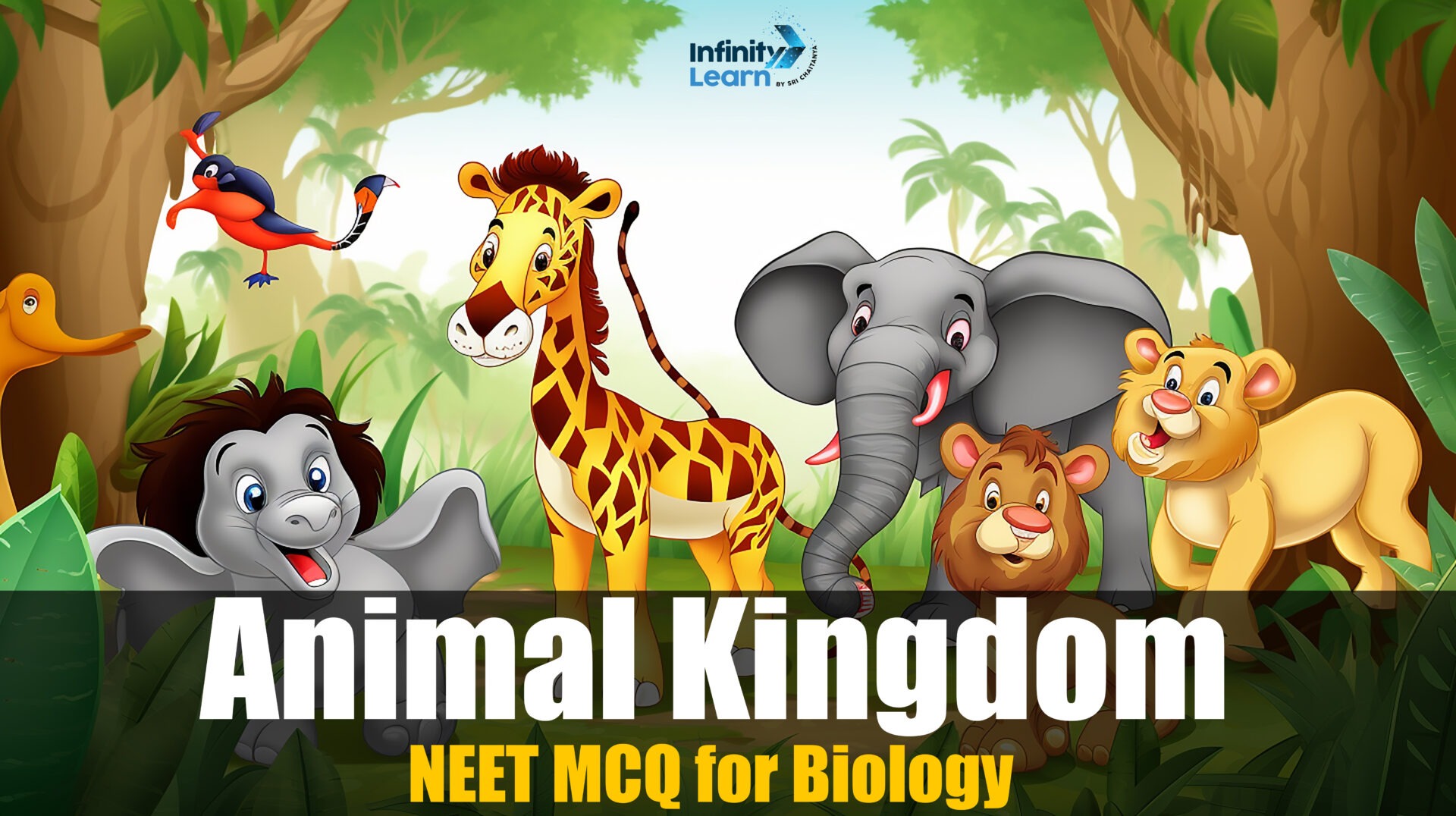Table of Contents
Animal Kingdom NEET MCQ: Preparing for NEET can be challenging, but with the right resources, aspirants can excel. Here, we provide a set of multiple-choice questions (MCQs) on the Animal Kingdom, complete with answers. These questions are designed to help students understand the concepts better and practice effectively for the NEET exam.
Students can learn important topics that require emphasis by studying these NEET MCQs, ensuring a thorough understanding of the material. Examine these carefully chosen questions to move one step closer to easily passing NEET.

Animal Kingdom NEET MCQ
The Animal Kingdom is a most important topic in NEET Biology and is an important part of the NEET syllabus. It is essential for NEET aspirants to comprehend the diversity, classification, and distinctive qualities of animals. Practice with multiple-choice questions (MCQs) that are directly related to Animal Kingdom can be quite helpful in helping you grasp this subject.
Animal Kingdom NEET MCQ with Answers
Q1. Which phylum do organisms with a water vascular system belong to?
A) Annelida
B) Arthropoda
C) Mollusca
D) Echinodermata
Answer: D) Echinodermata
Q2. Which of the following describes a cnidarian’s characteristics?
A) Presence of a notochord
B) Bilateral symmetry
C) Radial symmetry
D) Segmented body
Answer: C) Radial symmetry
Q3. In which of the following phyla is the notochord present throughout life?
A) Porifera
B) Annelida
C) Chordata
D) Echinodermata
Answer: C) Chordata
Q4. Which class of animals is characterized by the presence of mammary glands?
A) Aves
B) Reptilia
C) Mammalia
D) Amphibia
Answer: C) Mammalia
Q5. A flatworm is one of the following organisms?
A) Ascaris
B) Hydra
C) Planaria
D) Earthworm
Answer: C) Planaria
Q6. What type of coelom is found in Annelida?
A) Acoelomate
B) Pseudocoelomate
C) Coelomate
D) None of the above
Answer: C) Coelomate
Q7. Which class includes animals with feathers and a beak?
A) Mammalia
B) Aves
C) Reptilia
D) Amphibia
Answer: B) Aves
Q8. Which of the following best describes an arthropod?
A) Jointed appendages
B) Radial symmetry
C) Absence of segmentation
D) Acoelomate condition
Answer: A) Jointed appendages
Q9. What is the primary excretory structure in flatworms?
A) Nephridia
B) Flame cells
C) Malpighian tubules
D) Kidneys
Answer: B) Flame cells
Q10. What kind of creature possesses a pseudocoelom?
A) Earthworm
B) Ascaris
C) Hydra
D) Planaria
Answer: B) Ascaris
Q11. What kind of symmetry do mature echinoderms display?
A) Bilateral symmetry
B) Radial symmetry
C) Asymmetry
D) Pentamerous radial symmetry
Answer: D) Pentamerous radial symmetry
Q12. In which phylum are creatures with a segmented body and chitin-based exoskeleton found?
A) Annelida
B) Arthropoda
C) Mollusca
D) Echinodermata
Answer: B) Arthropoda
Q13. Which type of chordates include organisms without scales and with glandular, moist skin?
A) Mammalia
B) Aves
C) Reptilia
D) Amphibia
Answer: D) Amphibia
Q14. Which of the following structures is unique to mollusks?
A) Notochord
B) Radula
C) Water vascular system
D) Nephridia
Answer: B) Radula
Q15. In which phylum are organisms with a lophophore feeding structure found?
A) Annelida
B) Mollusca
C) Bryozoa
D) Arthropoda
Answer: C) Bryozoa
Q16. Which class of vertebrates is characterized by the presence of a cartilaginous skeleton?
A) Osteichthyes
B) Chondrichthyes
C) Mammalia
D) Amphibia
Answer: B) Chondrichthyes
Q17. What characteristic sets birds apart from other animals?
A) Cold-blooded
B) Lay eggs with leathery shells
C) Presence of feathers
D) Live birth
Answer: C) Presence of feathers
Q18. What is the common name for members of the phylum Porifera?
A) Jellyfish
B) Sponges
C) Starfish
D) Flatworms
Answer: B) Sponges
Q19. Which phylum comprises creatures with a genuine coelom and a segmented body?
A) Annelida
B) Nematoda
C) Platyhelminthes
D) Porifera
Answer: A) Annelida
Q20. Which class of vertebrates is characterized by the presence of hair or fur?
A) Amphibia
B) Reptilia
C) Aves
D) Mammalia
Answer: D) Mammalia
High Level Animal Kingdom NEET MCQ
Q1. Which of the following structures is not found in hemichordates?
A. Segmental body organization
B. Stomochord
C. Rudimentary notochord
D. Proboscis gland
Answer: A. Segmental body organization
Q2. The body cavity that forms from mesoderm splitting is called:
A. Pseudo-coelom
B. Coelom
C. Hemocoel
D. Blastocoel
Answer: B. Coelom
Q3. Choanocytes are primarily located in the:
A. Outer epithelium
B. Inner epithelium
C. Mesoglea
D. Spongocoel
Answer: B. Inner epithelium
Q4. Unlike other metazoans, coelenterates possess:
A. Nematocysts
B. Gemmules
C. Radial symmetry
D. Polymorphism
Answer: C. Radial symmetry
Q5. Which organism does not have a medusa stage?
A. Jellyfish
B. Hydra
C. Obelia
D. Corals
Answer: B. Hydra
Q6. An unsegmented, triploblastic mammal with a full digestive tract is a:
A. Planaria
B. Liver fluke
C. Hydra
D. Roundworm
Answer: D. Roundworm
Q7. Which animal uses a modified mantle cavity for jet propulsion?
A. Snail
B. Oyster
C. Squid
D. Chiton
Answer: C. Squid
Q8. Which feature is not found in Agnatha?
A. Parasites
B. Jawless mouth
C. Paired fins
D. Horny teeth
Answer: C. Paired fins
Q9. Which is a distinguishing feature of sponges?
A. Tissue level of organization
B. Presence of Ostia
C. Extracellular digestion
D. Indirect development
Answer: B. Presence of Ostia
Q10. Which phylum primarily consists of marine animals, but also includes some freshwater species?
A. Annelida
B. Porifera
C. Mollusca
D. Chordata
Answer: C. Mollusca
Benefits of Practicing Animal Kingdom MCQ for NEET
- Enhanced Understanding: Repeatedly solving multiple-choice questions (MCQs) helps solidify the ideas covered in class. Students who respond to questions often are better able to remember and comprehend the nuances of the Animal Kingdom.
- Exam Readiness: Students get acquainted with the structure and tone of questions that occur in NEET by practicing multiple-choice questions. This boosts self-confidence and reduces exam anxiety.
- Identifying Weak Areas: Through consistent practice, students can identify which areas they are weak in and need more focus. Planning for studies can be done effectively with this focused approach.
- Time Management: MCQs help students become more accurate and fast, which is important when it comes to the real NEET exam, when time management is essential.
- Active Learning: MCQs promote active learning by asking students to apply their knowledge, recollect facts, and engage in critical thought. Deeper learning and comprehension are encouraged by this direct interaction with the subject matter.








